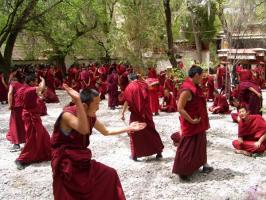Chinese Dragon & Phoenix
Dragon
The dragon is commonly called Long in China. As a primitive totem of the Chinese people it can date back to the Neolithic period. This sacred animal in the ancient Chinese legend, it is referred to as the divine mythical creature that brings with it ultimate abundance, prosperity and good fortune. Its benevolence signifies greatness, goodness and blessing; it symbolizes excellence, valiancy and boldness, heroism, perseverance, nobility and divinity.
Actually, the Chinese dragon is an imaginative combination from different parts of the animals. For example, its horns are from the deer, head from the buffalo, noses and teeth from the lion, palps from the shrimp, body from the snake, scales and tail from the fish, and claws from the eagle etc. This creature can run, fly and swim, even stir up the clouds and bring rain to the people if they pray it for. According to the Chinese legends, the dragons live in the heaven, the rivers, the wells, lakes and the seas. They usually hide not appear at random, they fly to the heaven in spring and hide in the water in fall.
Deeply rooted in Chinese culture, dragon and phoenix were regarded as the most scared animals and used to be emblems of emperor and empress. The Chinese dragon is traditionally the embodiment of the concept of yang (male), while phoenix was paired (yin, female) with dragon. They were used as decorative signs on the buildings, clothing and other daily uses articles of imperial palace to highly show off that the emperor as real dragon and son of heaven. Even the bed he sleep on was called "dragon bed", while throne be the "dragon seat", other Chinese vocabularies like "phoenix carriage" and so on were common to show their heaven-sent status.
Long or Chinese Dragon is unlike the evil dragon in the west; it was a gracious creature that able to do almost everything, flying into the sky and live in the deep ocean or lake. For ancient Chinese people, Lung is an ideal animal that was worshiped as the ruler of river, lake and sea, bringing rain and water to the earth. He is friendly and wise and honored in the temple being built. Lung gradually adopted the meaning of power and boldness, intelligent and ambitious, heroism and nobility, and then referred to the authority and power of imperial house.
Chinese dragons are frequently connected with number 9, as it is a number that of emperor, when combined with number 5, signified the supreme statue of the emperor. The "nine dragon wall" in Forbidden City, displaying in brilliant colors, each playing with a pearl, was carved vividly.
Chinese Dragon Dance was originated in Han Dynasty, as important as Lion Dance in Chinese culture. The Dragon Dance signifies the end of year and the coming of New Year, always performing on big occasions, Chinese New Year celebrations and important opening ceremony. It requires a group of people coordinate their movements with each other when dancing; any mistake would disturb the entertainment. Each team member must be able to leap, crouch and change the direction and pace of movements, requiring discipline, stamina and a substantial amount of practice.
Along with Chinese calendar, there are 12 different animals representing a cycle of 12 years, each for one year. Long is among these animals, which the year of it called "year of dragon". It is said that the one who born on year of dragon has some personal traits of dragon; he would be confidence and set high standards for himself, and will not listen to others. So dragon years are popular to have babies. In Chinese horoscopes there are specific about love partnership with other animal signs with the one born in Dragon year. For example, dragon and dragon, it is said that they can accomplish anything together; and a dragon & rooster make a good couple, but not to be egotistic; dragon & pig can keep caring and deeply affectionate relationship. Some Chinese people believe in this destiny but efforts would also need to maintain long loving relationship.
Chinese dragon was firstly adopted as the imaginary animal in prehistoric tribe, and then discovered as decoration on the bronze vessels of Shang Dynasty (over 3,000 years ago). Earliest legends described it an animal with fish scales and long beard. With years by, people acquiring sneaker's neck, tiger's paw, eagle's claw and other and other distinctive features of other animals until it became what we see today.
Nine Dragon Screen (Nine Dragon Wall) in Beijing Forbidden City
In China, the dragon permeates through the great Chinese civilization because the people have special worship to the dragon. In the old dynasties, the dragon was the emblem of the emperor and the imperial power. It was referred to something about the emperor, such as, the royal court was called dragon court, the imperial robe was called dragon robe, the son of the emperor was call dragon son, the face of the emperor was called dragon face, emperor's head was called dragon head...very interesting; dragon ranks the fifth among the twelve animals in the animal Chinese birth year; this animal is considered celestial in China, numerous dragon shrines and altars are set up across the country; the images of dragon are usually seen in the Chinese lanterns, the dragon boats, bridges, temples, the emperors' clothes and equipages, and royal buildings etc; there are many current idioms and literary quotations are related to the dragon in China; some Chinese people even take the character of dragon as their family name; nearly all the Chinese parents hope their sons become dragons (means become a useful person) when they grow up and possess the energetic, decisive, optimistic, intelligent and ambitious like the dragon.
Dragon has been comparable as the symbol of the Chinese nationality itself from time immemorial. Currently, the Chinese people around the world proudly proclaim themselves the "Descendents of the Dragon". But now when people mention the Chinese dragon it is usually associated with China and the Chinese culture. Usually, the most directly way to know Chinese totem to the dragon is to watch their dragon dance performances during the Spring Festival or visit the Beijing Forbidden City.
Phoenix
Phoenix is a sacred bird in China. The Chinese phoenix, also called "Feng Huang", is the head of all birds. Feng is male and Huang female and usually called together Fenghuang, while paired with dragon it is female. Feng Huang has rare appearance, with colorful plumage. Many legends tell that this mystical bird, as the china dragon, was invented according to the parts of different animals or birds. Its head is from that of the wild goose, chin from the swallow, beak from the chicken, neck from the snake, body from the tortoise, feather from the scale of the dragon, buttocks from the female unicorn, tail from the fish and peacock. In Chinese legends, this bird is secular and known as the king of the birds. It represents the female though it has the male and female.
Chinese phoenix is also an immortal bird whose rare appearances signify the peace and prosperity, especially a new ruler ascent to the throne. It never old or dies, belongs to the fire in Five Elements. It is said that phoenix nirvana and rebirth out of ash, symbolize the constant striving spirit.
Phoenix is also the symbol of the emperor power in China. It attached to the dragon and used by the queen and concubines of the emperor. This bird is the emblem of wisdom, goodliness, peace, luck and harmony. Therefore, the Chinese parents often pin their hopes on their daughters to become a phoenix.
Images of ancient birds have appeared in China for 7,000 years, with the earliest historic piece with phoenix was a silk painting discovered in a tomb of the warring states period. Today, the images of the phoenix can be found in many Chinese folk arts. This imaginative bird had played a very important role in the ancient Chinese civilization.
Down the ages, Chinese "long" and dragon are the traditional totems embedded with people's blessing and hope and left deep imprint in Chinese civilization. Some are even combined the dragon and phoenix together to hope the harmony and happiness of marriage.
Other Sacred Animals
Qilin
The Chinese Qilin also spelled Kylin or Kirin, is one of the four sacred animals of ancient China and reversed by the Chinese people. This fictitious animal has moose body, buckhorn, fish scales, buffalo's tail and the horse hoof. In China, Qilin is a good omen that can bring peace and prosperity. It also symbolizes the more children, the more happiness so the ancient legends about the Qilin sending a son to the no-son family are frequently told today China.
The Qilin can be found in many Chinese buildings and paintings. If you have an opportunity to visit the Forbidden City or the Summer Palace you can see its stone or bronze statues. Wonderfully, the traditional paper Qilin dance performances still can be seen in some rural areas during the Spring Festival.
Sacred Tortoise
Sacred tortoise was also called divine tortoise or efficacious tortoise in ancient China. Of the Four Chinese Sacred Animals only the sacred tortoise is real. It is considered the longest lived among the animals and can foretell the future. The Chinese people regard it as the symbol of longevity. In the ancient times, when the great events were held the wizards used to burnt the tortoise shells to judge good or ill luck by the crack.
The sacred tortoise was ever paid great respect in China. Its stone or bronze carvings and statues were found in the ancient royal palaces, emperors' tombs and common people's houses. It symbolizes the age-long of the Chinese empire, the brightness and knowledge.
Lion
Lions are said to be guardians to human in Chinese legends and myths. They guard people's houses and drive away the evil spirits. Lion statues are widely used and very common in China. Today, In some China towns, on TV, or during the traditional Chinese festivals or some great events, you may watch Chinese worship this sacred animal by lion performance dance.
Red-crowned Crane
Red-crowned crane was once the symbol of Chinese in ancient times. In traditional Chinse painting, the painters like this bird very much and frequently draw it on their paper. As early as the Spring & Autumn and the Warring States Periods (772-475 B.C.), the red-crowned crane figures were found in the bronze wares and many sacrificial vessels. In Taoism, this bird stands for longevity and the immortal.

 China Hiking & Trekking Tours
China Hiking & Trekking Tours .jpg) Family China Tours
Family China Tours  China Tours for Religions
China Tours for Religions

